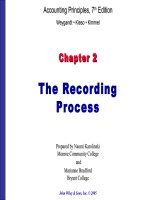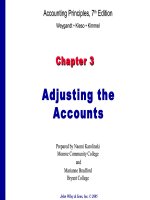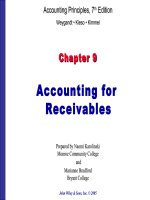Accounting principles 7th kieso kimel chapter 05
Bạn đang xem bản rút gọn của tài liệu. Xem và tải ngay bản đầy đủ của tài liệu tại đây (1.79 MB, 63 trang )
Accounting Principles, 7th Edition
Weygandt • Kieso • Kimmel
Chapter 5
Accounting for
Merchandising
Operations
Prepared by Naomi Karolinski
Monroe Community College
and
Marianne Bradford
Bryant College
John Wiley & Sons, Inc. © 2005
CHAPTER 5
ACCOUNTING FOR
MERCHANDISING OPERATIONS
After studying this chapter, you should be able to:
1 identify the differences between a service
enterprise and a merchandising company
2 explain the entries for purchases under a
perpetual inventory system
3 explain the entries for sales revenues under a
perpetual inventory system
4 explain the steps in the accounting cycle for a
merchandising company
CHAPTER 5
ACCOUNTING FOR MERCHANDISING
OPERATIONS
After studying this chapter, you should be able to:
5 distinguish between a multiple-step and a
single-step income statement
6 explain the computation and importance of
gross profit
7 determine the cost of goods sold under a
periodic system
MERCHANDISING
COMPANY
A merchandising company buys and
sells goods to earn a profit.
1) Wholesalers sell to retailers
2) Retailers sell to consumers
Primary source of revenue is Sales
MEASURING NET
INCOME
• Expenses for a merchandiser are divided into
two categories:
1
Cost of goods sold
– The total cost of merchandise sold during the period
2
Operating expenses
– Expenses incurred in the process of earning sales revenue
(Examples: sales salaries and insurance expense)
• Gross profit is equal to Sales Revenue less Cost of
Goods Sold
INCOME MEASUREMENT
PROCESS FOR A
MERCHANDISING COMPANY
OPERATING CYCLES FOR A
SERVICE COMPANY AND A
MERCHANDISING COMPANY
INVENTORY SYSTEMS
Merchandising entities may use either:
1) Perpetual Inventory
Detailed records of the cost of each item are
maintained, and the cost of each item sold is
determined from records when the sale
occurs.
2) Periodic Inventory
Cost of goods sold is determined only at the
end of an accounting period.
PERPETUAL VS.
PERIODIC
COST OF GOODS SOLD
To determine the cost of goods sold
under a periodic inventory system:
1) Determine the cost of goods on hand at
the beginning of the accounting period,
2) Add to it the cost of goods purchased,
and
3) Subtract the cost of goods on hand at
the end of the accounting period.
PURCHASES OF
MERCHANDISE
STUDY OBJECTIVE 2
• Merchandise is purchased for resale to customers,
the account
– Merchandise Inventory is debited for the cost
of goods.
• Like sales, purchases may be made for cash or on
account (credit).
• The purchase is normally recorded
by the purchaser when the goods
are
received from the seller.
• Each credit purchase should be
supported by a purchase invoice.
PURCHASES OF
MERCHANDISE
SALES INVOICE
PURCHASES OF
MERCHANDISE
3,800
3,800
For purchases on account,
Merchandise Inventory is debited
and Accounts Payable is credited.
PURCHASE RETURNS AND
ALLOWANCES
• A purchaser may be dissatisfied with merchandise
received because the goods:
1) are damaged or defective,
2) are of inferior quality, or
3) are not in accord with the purchaser’s
specifications.
• The purchaser initiates the request for a reduction of
the balance due through the issuance of a debit
memorandum (purchaser’s debit decreases A/P!).
• The debit memorandum is a document issued by a
buyer to inform a seller that the seller’s account has
been debited because of unsatisfactory merchandise.
PURCHASE RETURNS AND
ALLOWANCES
300
300
For purchases returns and allowances,
Accounts Payable is debited and
Merchandise Inventory is credited.
FREE ON BOARD
A sales agreement should indicate whether the seller or the buyer is
to pay the cost of transporting the goods to the buyer’s place of
business.
• FOB Shipping Point
1) Goods placed free on board the carrier
by seller
2) Buyer pays freight costs
• FOB Destination
1) Goods placed free on board at
buyer’s business
2) Seller pays freight costs
ACCOUNTING FOR
FREIGHT COSTS
• Merchandise Inventory is debited if
buyer pays freight.
• Freight-out (or Delivery Expense) is
debited if seller pays freight.
ACCOUNTING FOR
FREIGHT COSTS
150
150
When the purchaser directly incurs the freight costs, the
account Merchandise Inventory is debited and Cash is credited.
ACCOUNTING FOR
FREIGHT COSTS
150
150
Freight costs incurred by the seller on
outgoing merchandise are debited to Freightout (or Delivery Expense) and Cash is credited.
PURCHASE DISCOUNTS
• Credit terms may permit the buyer to
claim a cash discount for the prompt
payment of a balance due.
• The buyer calls this discount a
purchase discount.
• Like a sales discount, a
purchase discount is based on
the invoice cost less returns
and allowances, if any.
PURCHASE DISCOUNTS
3,500
3,430
70
If payment is made within the discount period, Accounts
Payable is debited, Cash is credited, and Merchandise
inventory is credited for the discount taken.
PURCHASE
DISCOUNTS
3,500
3,500
If payment is made after the discount
period, Accounts Payable is debited and
Cash is credited for the full amount.
SAVINGS OBTAINED BY
TAKING PURCHASE
DISCOUNT
A buyer should usually take all available discounts.
If Beyer Video takes the discount, it pays $70 less in cash.
If it forgoes the discount and invests the $3,500 for 20 days
at 10% interest, it will earn only $19.44 in interest.
The savings obtained by taking the discount is calculated as
follows:
SALES TRANSACTIONS
STUDY OBJECTIVE 3
• Revenues – (Revenue recognition
principle)
– Earned when the goods are transferred
from seller to buyer
• All sales should be supported by a
document such as a cash register tape or
sales
invoice.
RECORDING CASH SALES
2,200
2,200
1,400
1,400
For cash sales, Cash is debited and Sales is credited.
For the cost of goods sold for cash, Cost of Goods
Sold is debited and Merchandise Inventory is
credited.









